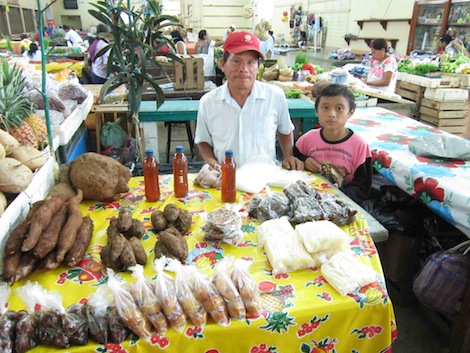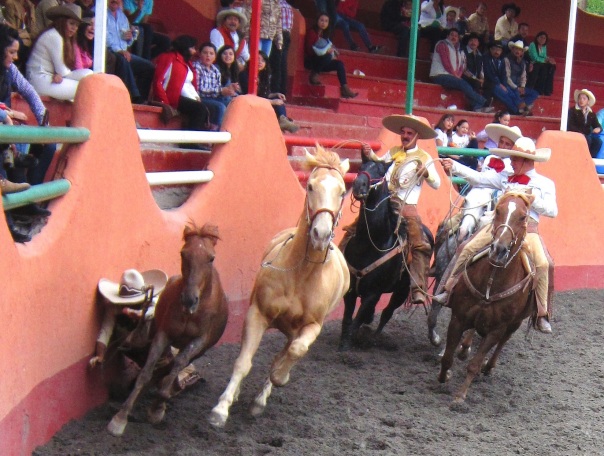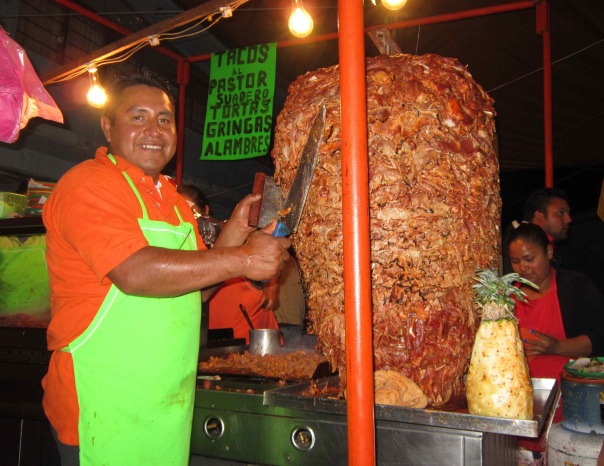A Spanish Cheat Sheet for Travelers in Mexico
Updated November 2016
When you travel in any foreign land, whether Mexico, China, or Quebec, it’s a good idea to learn some basic phrases in the local language.
At one time I must have known how to say hello, goodbye, thank you, sorry, bathroom, and beer in at least 10 languages.
Starting your conversation in the local language shows respect, and it earns respect.
A small effort — memorizing phrases or keeping a cheat sheet in your pocket — will instantly separate you from hordes of travelers loudly making demands in English.
So even if you’re in an all-inclusive resort in Cancun, where even the elevator speaks English, take some time before and during your trip to learn a little Spanish.

Start with:
¿Habla usted inglés? Do you speak English?
No hablo español I don’t speak Spanish
Tip: Find a way to hear how Spanish words are pronounced while you learn them. Don’t pronounce them as you would in English, or they won’t make sense.
Then learn some essentials:
Hola Hello
Adiós Goodbye
Sí Yes
No No
Por favor Please
Gracias Thank you
Gracias is also how you say no thanks. Translating the no as in no, gracias is unnecessary.
Tip: When someone wants to sell you something that you don’t want, a quick gracias with a firm tone of voice conveys no thanks.

More important words for courtesy:
Perdón A catch-all excuse me or sorry
Disculpe Sorry, or excuse me when you want someone’s attention
Con Permiso Excuse me when you want someone to let you get by
¿Mande? The Mexican way to ask what? when you don’t understand what someone said.
Greetings are crucial in Mexico. Mexicans use them before engaging in any communication — in a store, restaurant, hotel, etc. It’s polite to use these at the right time of day:
Buenos días Good morning
Buenas tardes Good afternoon (often used until after sundown)
Buenas noches Good night (but not in the sense of going to bed)
Also say:
¿Qué tal? What’s up?
¿Qué pasó? What’s up?
¿Qué onda? What’s up? (used in Mexico)
Once you’ve learned all of the above, learn more questions. Questions are the key to any conversation:
¿Cómo estás? How are you?
¿Cómo te llamas? What’s your name?
¿De dónde eres? Where are you from?
¿Erés de aquí? Are you from here?
¿Que hora es? What time is it?
¿Donde esta X? Where is X (downtown, the hotel, the restaurant, the park etc.)
¿Donde estamos? Where are we?
Tip: An intermediate or advanced student may notice that these questions use the tú form rather than the more formal usted form. While it is true that usted is more polite, and in many Latin American countries, such as neighboring Guatemala, usted is the norm, in Mexico it’s ok to use tú, especially when you are a beginning Spanish speaker. Make it easy on yourself — save usted for later.

Learn the question words: Who, what, where, when, why, how…
¿Quién? Who?
¿Qué? What?
¿Dónde? Where?
¿Cuándo? When?
¿A que hora? When/what time?
¿Por qué? Why?
¿Cómo? How?
¿Cuánto? How much?
¿Cuántos? How many?
¿Cada cuanto? How often?
¿Por cuánto tiempo? How long?
Then some easy vocabulary to use with the question words:
Baño Bathroom
Restaurante Restaurant
Hotel Hotel
Parque Park
Centro Downtown
Tip: These are cognates, words that are the same or similar in both languages. Pronunciation is different, so listen to how they’re spoken. But…
Beware the false cognates, which look the same but have different meanings:
Apenado Embarrassed
Embarazada Pregnant
Actualmente Currently/now
De hecho Actually
Americano Person who comes from the continent America
Tip: The term Americano can be a source of controversy. Some Latin Americans take offense that people from the United States use it to refer only to themselves and not to people from the entire continent. I try to explain to them that it’s a linguistic decision because English lacks a convenient adjective for United Statesians to describe themselves.
Spanish, however, has that adjective: estadounidense. Norteamericano, North American, also refers to people from the U.S., and notice how it’s another false cognate, because in English Mexicans are North Americans too.
Mexican slang
Slang is essential in Mexican Spanish. Learn some, but be careful with the vulgar ones! Many words frequently spoken among men aren’t appropriate at the dinner table.
These are all common and harmless:
Chido Cool
Chela Beer
Camión Bus
¿Neta? Really?
¡No manches! No way/come on
Check out Top Ten Mexican Slang, its sequel, Top Twenty Mexican Slang, and my most comprehensive post on Mexican Spanish, my Mexican Slang Master List.
Ordering food and drinks
You will use these all the time:
Una cerveza por favor A beer please
Otra (cerveza) por favor Another (beer) please
¿Me puedes dar dos tacos por favor? Can you give me two tacos please?
¿Cuánto cuesta esto? How much does this cost?
Tip: ¿Cuánto cuesta?, while correct, is high-school textbook Spanish. To sound more natural, you can say ¿Qué precio tiene? — literally What price does it have?
Some common (and good) Mexican food:
Tacos al pastor Pastor tacos, seasoned pork. Good and reliable.
Alambre Like fajitas, meat cooked with onions and peppers
Gringa A flour tortilla folded flat with cheese and meat
Enchiladas Rolled-up tortillas, chicken (usually), cheese, lettuce, green sauce
Chilaquiles Nachos with cheese in green sauce
Huarache A big, thick, flat tortilla with beans, cheese, sauce, and anything
Pozole Red soup, chicken (usually), big corn, vegetables (really good)
Mole A sauce of many ingredients, can be red, green, black, and more
Chiles rellenos Stuffed bell peppers
Chiles en nogada Perhaps my favorite food in Mexico
Coctel de camarón Shrimp cocktail
Filete de pescado Filet of fish, can be prepared many ways
You can find more in my Ultimate Guide to Authentic Eating in Mexico.
Tip: Learn words for regional food, such as Cochinita Pibil in Merida or Tortas Ahogadas in Guadalajara. Food names don’t have English translations, so don’t let the occasional bizarre or unappetizing English translation put you off.

Transportation
The bus is the easiest way to travel around Mexico. In most cases you’ll need to buy bus tickets in Spanish.
Uno para Guadalajara por favor One (ticket) for Guadalajara
Dos para Playa del Carmen Two (tickets) for Playa del Carmen
Tres para el aeropuerto Three for the airport
¿A que hora sale el camión? What time does the bus leave?
Tip: Learn the numbers, 1-20, and then 20-100
To learn more Spanish while traveling:
You could buy a traveler’s phrasebook…
Phrasebooks have sections for any situation you might encounter, like at the doctor’s office or in a supermarket.
You won’t really learn Spanish with one of these, though it won’t hurt. They are good to have in an emergency.
This one isn’t for travelers, and it isn’t exactly a phrasebook, but I recommend it because it’s a good starting point, as it lists all the basics but is less focused on translation and more on learning:
This post contains affiliate links.
Tip: If you have a Spanish phrasebook, then before you go to the pharmacy or wherever you must speak Spanish, write down what you want to say and hand it over. If you really don’t know Spanish, you won’t know how to pronounce the phrases and no one will understand you anyway.
Or actually learn Spanish
I have some suggestions for learning Spanish here: Study Spanish. Read the newspaper, listen to music, download the lyrics, and most importantly, don’t be afraid to speak. Don’t let yourself be discouraged by the store clerk who doesn’t understand what you want or the waitress who brings you something different from what you ordered.
Of course, why not buy a workbook and study as you travel? Fifteen minutes in the morning, and then you can practice all day. To learn all the basics of grammar in the clearest way possible, I recommend:
It’s paperback size, easy to use, and good for the both the total beginner and upper intermediate student.
Traveling is your best opportunity to learn. Write down words you hear often. Write down phrases you think you’ll need. Use them as much as possible.
Ask questions all the time. Read the newspaper. Carry a notebook. Keep your ears open. Be willing to get stuck in some situations where you understand nothing.
It will pay off. Being immersed in a Spanish-speaking country while traveling is your absolute best way to learn the language, if you have the right attitude, that is.
Please click here for more books I recommend for studying Spanish.
And don’t miss my newly-published Mexican Slang Master List, with more than 100 words and phrases of Mexican Spanish.
Practice your Spanish while traveling in Chiapas or the Mayan Riviera, two top destinations in Mexico. You will save the low price of my Cancun and Mayan Riviera 5-Day Itinerary or Your Chiapas Adventure: San Cristobal de las Casas and Palenque the first time you follow my advice on a bus, restaurant, hotel or cenote.
Posted on March 1, 2014, in Learning Spanish, Travel, Travel in Mexico and tagged learning spanish, mexian slang, Mexican food, ordering mexican food, spanish grammar books, spanish phrasebooks, spanish phrases, traveler's spanish. Bookmark the permalink. 17 Comments.




Gracias
LikeLike
I have enjoyed your blog immensely and have gleaned a great deal. You have renewed my interest in furthering my my Latin American studies especially Mexican Spanish which seems to be spoken here in the US. I had purchased an English/Mexican dictionary in Guadalajara years ago, loaned it out and never saw it again. I am always open to suggestions as you have mentioned many, thank you! Mark
LikeLike
What a nice compliment, thank you so much!
LikeLike
Thanks for the help
Ya go mexico
LikeLike
alright
LikeLike
“Disculpa” should generally be “Disculpe” since you are saying it to strangers, and thus want to use the “usted” form. Also, Mexicans use “disculpe” WAY more than perdón.
A book that was useful to me on my (continuing) road to fluency is Breaking out of Beginner’s Spanish, by Joseph Keenan. Not only is it a great guide to a lot of things you wouldn’t likely read in a textbook, it’s just a good read too.
Saludos,
Kim G
Boston, MA
Where we’ve been enjoying poking around your blog.
LikeLike
I’ll check out that book, thanks!
LikeLike
Pingback: Language – Here in Oaxaca
Pingback: 10 Tips for an Incredible Trip: – Marina & Lawrence
Pingback: My Top Tips for Travelers to Mexico | No Hay Bronca
Pingback: What To Expect When Traveling In Mexico
Pingback: What to Pack for a Trip to Mexico | No Hay Bronca
Pingback: 7 Tips for Budget Travel in Cancun and the Mayan Riviera | no hay bronca
Pingback: Tips for Travel to Cancun On A Budget | Cancun Cosmetic Dentistry
Pingback: Tips for Travel to Cancun On A Budget | Cancun Cosmetic Dentistry | Cancun Cosmetic Dentistry
Pingback: A Spanish Cheat Sheet for Travelers in Mexico | ivanjay99
Pingback: Top Ten Mexican Slang | no hay bronca